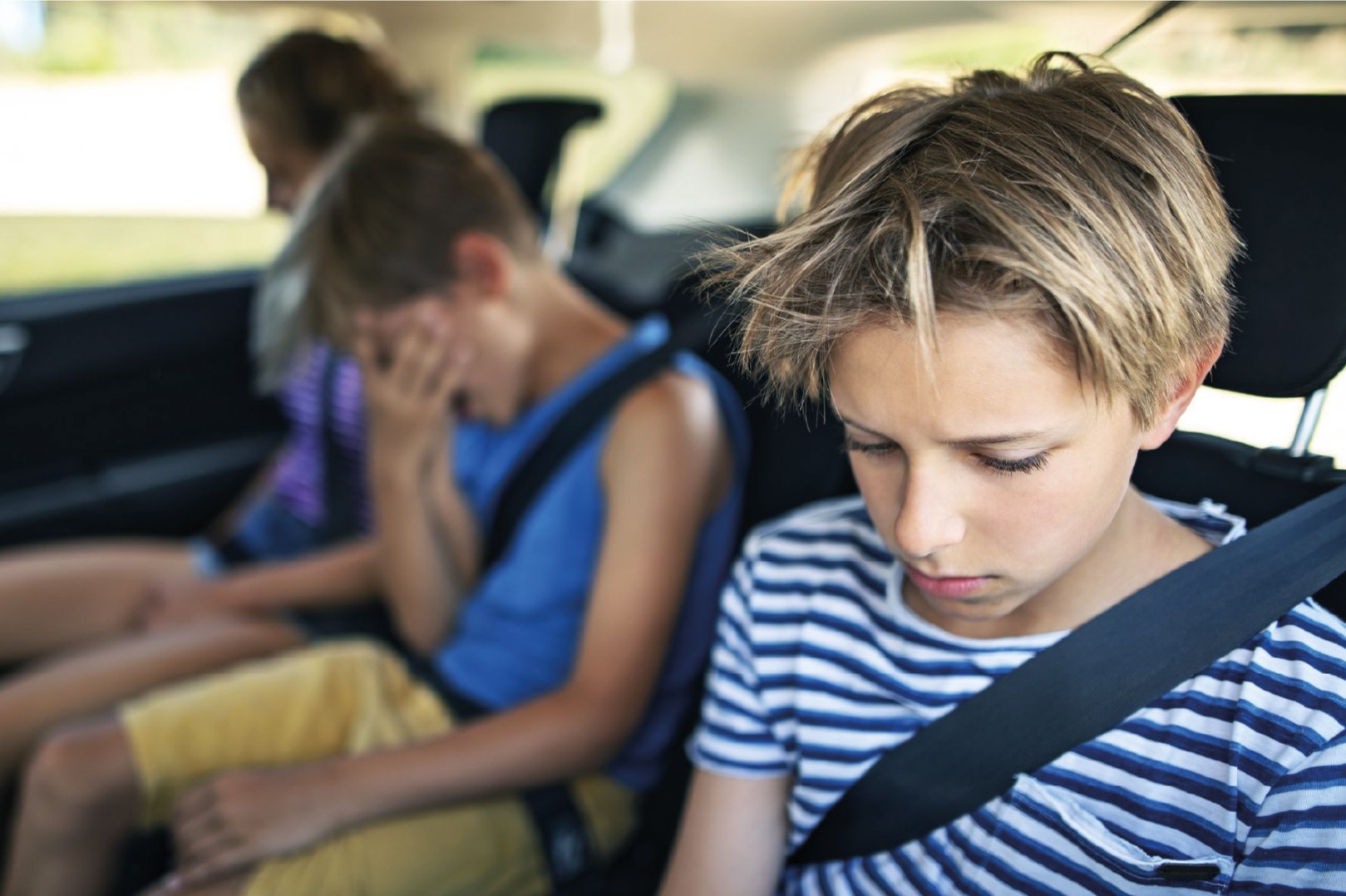
Seasickness or car sickness: what causes motion sickness?
Motion sickness is a complex of symptoms that usually includes nausea, often accompanied by vague abdominal discomfort, vomiting, confusion, pallor, diaphoresis and related symptoms
It is induced by specific forms of movement, particularly repetitive angular and linear acceleration and deceleration, or as a result of conflicting vestibular, visual, and proprioceptive stimuli.
Behavioural changes and drug therapy can help prevent or control symptoms.
Motion sickness is a normal physiological response to a provocative stimulus
- Individual susceptibility to motion sickness varies widely; however, it occurs more frequently in women and children between the ages of 2 and 12 years.
- Motion sickness is rare after the age of 50 and in children < 2 years.
- The incidence ranges from < 1% on aeroplanes to almost 100% on boats in rough sea conditions and in the absence of gravity during space travel.
Aetiology of motion sickness
The primary cause is excessive stimulation of the vestibular apparatus by movement.
Vestibular stimulation can result from angular motion (detected by semicircular canals) or linear acceleration or gravity (detected by otolithic organs [utricle and sacculus]).
Components of the central nervous system that mediate kinetosis include the vestibular system and the brainstem nuclei, the hypothalamus, the nodule and uvula of the cerebellum, and the haemetic pathways (e.g., the trigger zone of the medullary chemoreceptors, the vomiting centre, and the haemetic efferences).
The exact pathophysiology is not defined, but kinetosis only occurs when the 8th cranial nerve and cerebellar vestibular tracts are intact; those without a functional vestibulo-cocular system are immune to kinetosis.
Movement generated by any means of transport, including ship, motor vehicle, train, aircraft, spacecraft, as well as activities in recreational parks, can cause excessive vestibular stimulation.
The trigger may involve conflicting vestibular, visual and proprioceptive stimuli
For example, visual input indicating being stationary may conflict with the sensation of movement (e.g., looking at the walls of a ship’s cabin, evidently stationary, while feeling the boat roll).
Alternatively, visual inputs of movement may conflict with the lack of motion perception, e.g., viewing a fast-moving slide with a microscope or watching a virtual reality game while seated (also referred to as pseudo-kinetosis or pseudo-kinetosis, given the lack of actual acceleration).
When watching waves from a boat, a person may receive conflicting visual stimuli (the movement of the waves in one direction) and vestibular stimuli (the vertical movement of the boat itself).
Another possible trigger is the conflict in impulses between angular motion and linear acceleration or gravity, as can occur in an environment with zero gravity when turning (angular acceleration).
In addition, a motion pattern that differs from the expected pattern (e.g., in a zero-gravity environment, floating instead of falling) can be a trigger.
Risk factors
Factors that may increase the risk of developing motion sickness or increase the severity of symptoms include the following:
- Poor ventilation (e.g. exposure to vapours, smoke or carbon monoxide)
- Emotional factors (e.g., fear, anxiety about travelling or the possibility of developing motion sickness)
- Migraine headache
- Vestibulopathy (such as labyrinthitis)
- Hormonal factors (e.g. pregnancy or use of hormonal contraceptives)
- Genetic factors may also increase susceptibility to motion sickness
In space adaptation syndrome (kinetosis during space travel), one aetiological factor is weightlessness (zero gravity).
This syndrome impairs the efficiency of astronauts in the first few days of space flight, but adaptation occurs over several days.
General reference
Hromatka BS, Tung JY, Kiefer AK, et al: Genetic variants associated with motion sickness point to roles for inner ear development, neurological processes and glucose homeostasis. Hum Mol Genet 24(9):2700-2708, 2015. doi: 10.1093/hmg/ddv028
Symptomatology of kinetosis
The characteristic manifestations of motion sickness are nausea, vomiting, pallor, diaphoresis and vague abdominal discomfort.
Other symptoms, which may precede the characteristic manifestations, include yawning, hyperventilation, salivation, and drowsiness.
Aerophagy, confusion, headache, fatigue, weakness and inability to concentrate may also occur.
Pain, breathlessness, focal weakness or neurological deficits, and abnormalities of vision and speech are absent.
In the case of continuous movement, the patient often adjusts within several days.
However, symptoms may reappear if the movement increases in intensity or resumes after a short break from the initial trigger.
Prolonged episodes of vomiting due to motion sickness may, rarely, induce dehydration and arterial hypotension, inanition and depression.
Diagnosis of motion sickness
Clinical assessment
The diagnosis is suspected in patients with compatible symptoms who have been exposed to typical triggers.
The diagnosis is clinical and usually clear.
However, the possibility of another diagnosis (e.g., central nervous system haemorrhage or cerebral infarction) must be considered in some persons, particularly the elderly, patients without a positive history of motion sickness, or those with risk factors for central nervous system haemorrhage or infarction who develop acute confusional state and vomiting (or dizziness) during travel. Patients with focal neurological symptoms or signs, significant headaches, or other atypical findings of motion sickness should be further evaluated.
Treatment of motion sickness
- Prophylactic drugs (e.g. scopolamine, antihistamines, antidopaminergic drugs)
- Prophylaxis and non-pharmacological treatment measures
- Anti-emetic drugs (e.g. serotonin antagonists)
- Sometimes EV replenishment of fluids and electrolytes
Persons predisposed to motion sickness should take prophylactic drugs and use other preventive measures before symptoms appear; interventions are less effective after symptoms develop.
If vomiting occurs, an antiemetic, administered rectally or parenterally, may be effective.
If vomiting is prolonged, EV fluids and electrolytes may be required for replenishment and maintenance.
Pregnant women should treat motion sickness as they would treat nausea and vomiting during early pregnancy.
Scopolamine
Scopolamine, a prescription anticholinergic drug, is effective for prevention, but efficacy in treatment is uncertain.
Scopolamine is available as a 1.5 mg transdermal patch or in an oral formulation.
The patch is a good choice for longer journeys, as it is effective for up to 72 h.
It is applied behind the ear 4 h before the time when its effect is required.
If treatment is required after 72 h, the patch is removed and a new one is placed behind the other ear.
The oral scopolamine preparation is effective within 30 minutes and is administered at a dosage of 0.4-0.8 mg 1 h before travel and then every 8 h as needed.
Adverse anticholinergic effects, which include drowsiness, blurred vision, dry mouth and bradycardia, are less frequent with patches
Accidental contamination of the eye with patch residues may cause persistent and large pupil dilation.
Additional adverse effects of scopolamine in the elderly may include confusion, hallucinations and urinary retention.
Scopolamine is contraindicated in persons at risk of angle-closure glaucoma.
Scopolamine may be used in children > 12 years at the same dosage as adults.
Use in children ≤ 12 years may be safe but is not recommended due to the higher risk of adverse effects.
Antihistamines
The mechanism of action of antihistamines is probably anticholinergic.
All effective ones are sedative; non-sedative antihistamines do not appear to be effective.
These drugs may be effective for prevention and eventual treatment.
The adverse effects of anticholinergics can be bothersome, particularly in the elderly.
Starting 1 h before departure, dimenhydrinate, diphenhydramine, meclizine, or cyclizine in the following dosages may be administered without prescription to sensitive persons:
- Dimenhydrinate: adults and children > 12 years, 50 to 100 mg orally every 4-6 h (not to exceed 400 mg/day); children 6 to 12 years, 25 to 50 mg orally every 6-8 h (not to exceed 150 mg/day); children 2 to 5 years, 12.5-25 mg orally every 6-8 h (not to exceed 75 mg/day)
- Diphenhydramine: adults, 25 to 50 mg orally every 4-8 h; children ≥ 12 years, 25 to 50 mg orally every 4-6 h; children 6 to 11 years, 12.5-25 mg orally every 4-6 h; children 2 to 5 years, 6.25 mg orally every 4-6 h
- Meclizine: adults and children ≥ 12 years, 25-50 mg orally every 24 h
- Cyclizine: adults, 50 mg orally every 4-6 h; children 6-12 years, 25 mg 3 or 4 times/day
Cyclizine and dimenhydrinate may minimise vagus-mediated gastrointestinal symptoms.
Antidopaminergic drugs
Promethazine 25 to 50 mg orally 1 h before departure and then 2 times/day appears to be effective for both prevention and treatment.
The dosage in children aged 2 years to 12 years is 0.5 mg/kg orally 1 h before starting and then 2 times/day; it should not be used in children < 2 years because of the risk of respiratory depression.
The addition of caffeine may increase efficacy.
Metoclopramide may also be effective, but studies show that it is less so than promethazine.
Adverse effects include extrapyramidal symptoms and sedation.
Benzodiazepines
Benzodiazepines (e.g. diazépam) may also have some benefit in the treatment of motion sickness, but they have sedative effects.
Serotonin antagonists
Serotonin (5-HT3) antagonists, such as ondansetron and granisetron, are highly effective antiemetics, but the few studies addressing their use in the prevention of motion sickness have not shown significant efficacy.
However, in cases of severe nausea and vomiting, it is reasonable to use serotonin antagonists. Examples of potential dosages of ondansetron are as follows:
- Adults: 4 mg to 8 mg orally every 8-12 h
- Children 6 months to 10 years: 8 to 15 kg, 2 mg orally; > 15 kg, 4 mg orally
Non-pharmacological measures
Susceptible individuals should minimise exposure to triggers by positioning themselves where there is least movement (e.g. in the middle of a narrow boat near water level, at wing level in an aircraft).
In addition, one should try to minimise the difference between visual and vestibular stimuli.
When travelling in a motor vehicle, it is therefore best to drive or travel in the front seat next to the driver, where the movement of the vehicle is most evident (or where the movement is most visible).
When travelling on a ship, the view of the horizon or land is usually better than the view of a cabin wall.
Whatever the form of transport, reading and rear-facing seats should be avoided.
The best position is supine or semi-reclining with the head resting. Sleeping can also help as it reduces the vestibular sensory stimulus.
In spatial adaptation syndrome, movement should be avoided, which aggravates the symptoms.
Adequate ventilation helps prevent symptoms.
Consumption of alcoholic beverages and overeating before or during travel increase the likelihood of motion sickness.
During long trips, frequent intake of small amounts of fluids and light food is preferable to heavier meals; some individuals find dry crackers and carbonated drinks, particularly ginger ale, more suitable.
If the trip is short, food and liquids should be avoided.
Adaptation is one of the most effective prophylactic therapies for motion sickness and is achieved by repeated exposure to the same stimulus.
However, adaptation is stimulus-specific (e.g., sailors who adapt to movement on large boats may still develop motion sickness when on smaller boats).
Alternative therapies
Some alternative therapies are yet to be tested but may be useful.
These alternative therapies include the use of cuffs that perform acupressure and cuffs that administer electrical stimuli.
Both can certainly be used by people of all ages.
Ginger (0.5 to 1 g, which can be repeated but should be limited to 4 g/day) has been used but has not been shown to be more effective than placebo.
Read Also:
Emergency Live Even More…Live: Download The New Free App Of Your Newspaper For IOS And Android
Emergency Rescue: Comparative Strategies To Exclude Pulmonary Embolism
Pneumothorax And Pneumomediastinum: Rescuing The Patient With Pulmonary Barotrauma
Barotrauma Of The Ear And Nose: What It Is And How To Diagnose It
Decompression Sickness: What It Is And What It Causes



